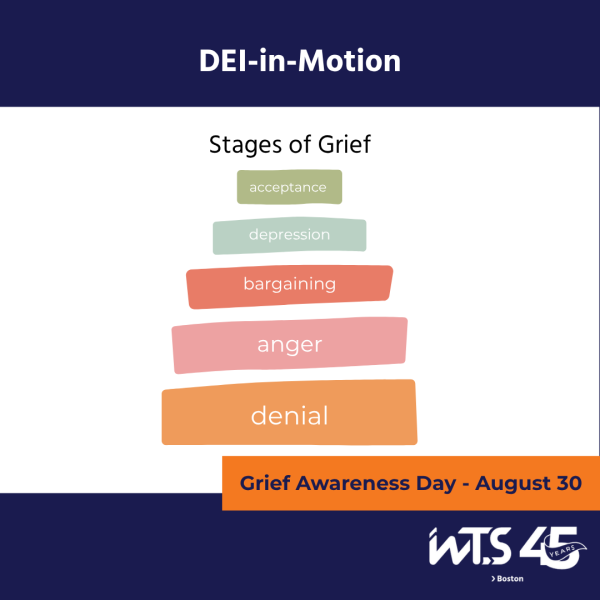WTS-Boston DEI in Motion: Grief Awareness Day is August 30
Grief Awareness Day – August 30

“Grief is like a long valley, a winding valley where any bend may reveal a totally new landscape.”
― C.S. Lewis, A Grief Observed
At one time in our not-so-distant past, people mourning the loss of a loved one would wear black for a year [1]. While some religions and cultures carry on this tradition with varying timespans, it’s not nearly as common. There isn’t a modern counterpart, although, a “Be Kind, I’m Grieving” pin would probably be worn by far more people than you would expect.
Because grief is invisible and can be uncomfortable to talk about, many people carry this unseen weight in silence, and it impacts every aspect of their lives – including work. Employers who acknowledge and support grieving employees foster a more compassionate and resilient work environment. People who are grieving often want to be able to tell their story, seek support, and feel permission to grieve [2].
Grief is more than just sadness. Its effects impact our emotional, cognitive, and physical wellbeing. Here’s what that can look like [3]:
- Emotional: Stress, anxiety, depression, exhaustion, anger, guilt, relief, numbness
- Cognitive: Decreased concentration, brain fog, troubles with memory and decision making, intrusive memories, hypervigilance
- Physical effects: Fatigue, illness, sleep disruption, appetite increase or decrease
When the workplace supports the employee during difficult times, they will see improved retention, morale, and engagement. Recognizing that grief doesn’t stop after the traditional three-day bereavement leave policy is one of the first steps. Normalizing grief – not just death but also miscarriage, pet loss, and over non-traditional losses – and normalizing support for grief, fosters a safe environment.
Railroad operators carry a weight few can understand, one that doesn’t end when the tracks clear. In this industry support systems should be set up to assist operators after traumatic events such as trespasses and suicides on the right of way. According to the US DOT and Federal Railroad Administration, train crews can often experience post-traumatic stress disorder (PTSD), anxiety, depression, and sleep disturbances after a traumatic event, and these can last for months. Managers and high-risk employees should receive trauma support training, and structured support should be offered after a critical incident (called a “Critical Incident Stress Plan”) [4].
Normalizing discussion of emotions, grief, and traumatic incidents helps employees who may be hesitant to ask for help. Oftentimes these topics are considered taboo, which can make it hard to express a need for support. Australia and New Zealand, have “R U Okay?” Day to inspire people to meaningfully connect with those in their world who may be struggling [5].
In prior years, Chicago METRA and Amtrak developed a “Breaking the Silence” campaign run in conjunction with Rail Safety Week to provide more open discussion of railway suicide both within the industry and with the public. Massachusetts Department of Transportation (MassDOT) posts signs with the Samaritans Inc. of Boston with a helpline number around the Commonwealth [6].
Things that can be done in the workplace are:
- Audit current grief-related policies.
- An EAP (Employee Assistance Program)
- Train leaders on compassionate communication and trauma risk management
- Normalize grief discussions in DEI and wellness efforts.
- Offer continuous—not just crisis-based—support.
- Peer support programs or an ERG for employees who may be impacted by the stigma of asking for help [7]
By offering trauma-informed care, prioritizing mental health support, and fostering a culture where asking for help can be spoken allowed, we honor the human behind the controls. Policies, programs, and compassion ensures that workers are supported, improve workplace safety, culture, and retention.
Books on Loss:
- “It’s OK That You’re Not OK” – Megan Devine
- “On Grief and Grieving” – Elizabeth Kübler-Ross, David Kessler
- “Water bugs and dragon flies, explaining death to young children” by Doris Stickney
- “Modern Loss” - Gabrielle Birkner and Rebecca Soffer
- “A Grief Observed” – C.S. Lewis
- For children – “The Rough Patch” – Brian Lies
The MBTA EAP compiled the following resources on grief:
- Pregnancy and Post-Partum Loss
- Bereavement Support and Referrals
- Grief support for families, teens, and children:
- Resources to find a provider, support group, or therapist
- Loss related to Substance Use Disorder
Sources
[1] https://www.lancasterhistory.org/victorian-mourning-dress/
[3] https://www.verywellmind.com/physical-symptoms-of-grief-4065135
[4] https://trespasstoolkit.fra.dot.gov/eLib/Details/L00056
[6] https://www.trains.com/trn/news-reviews/news-wire/29-metra-suicide-prevention/
Explore WTS-Boston's other pages here: WTS-Boston Homepage | News | Events